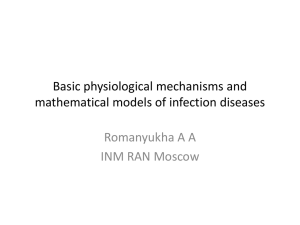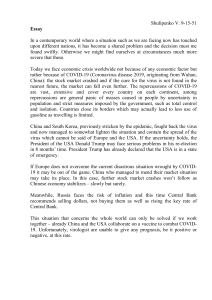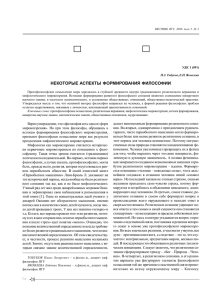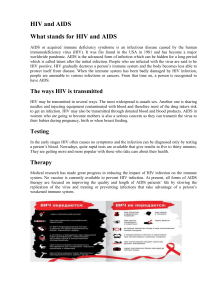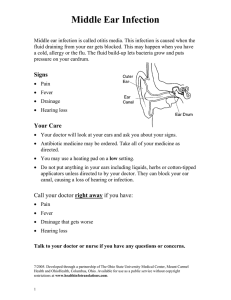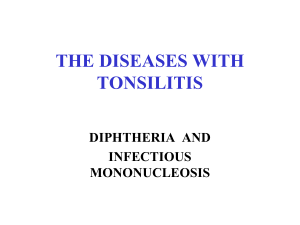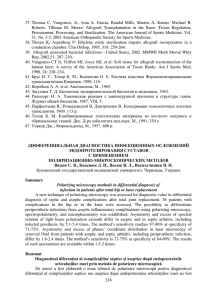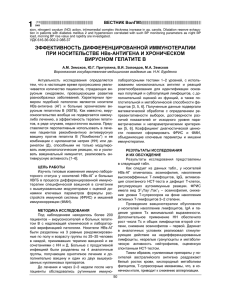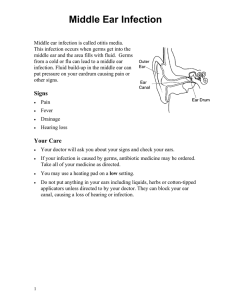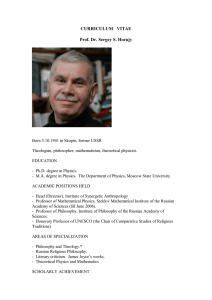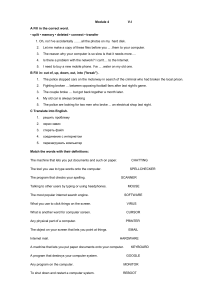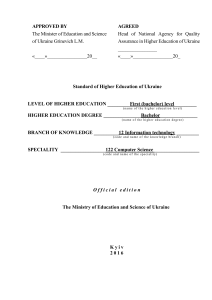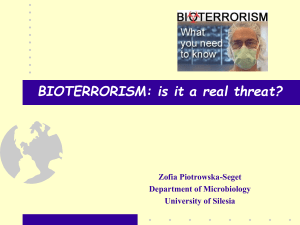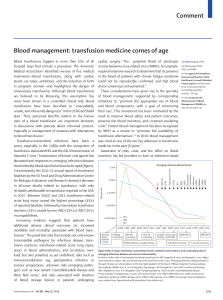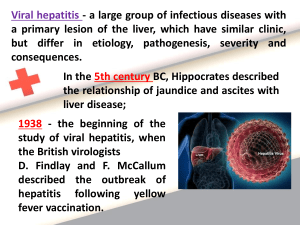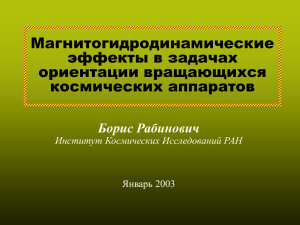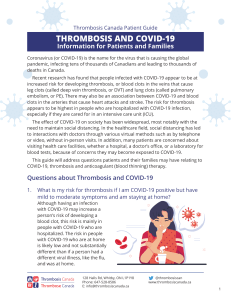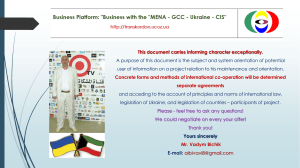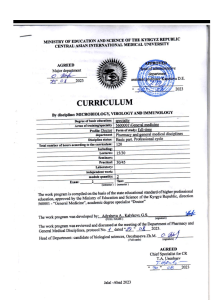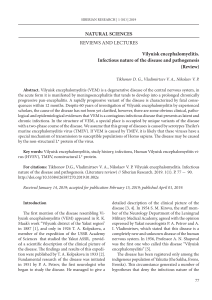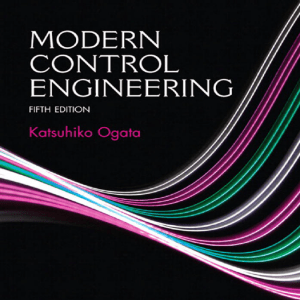О работах Г.И. Марчука в области математической иммунологии
advertisement
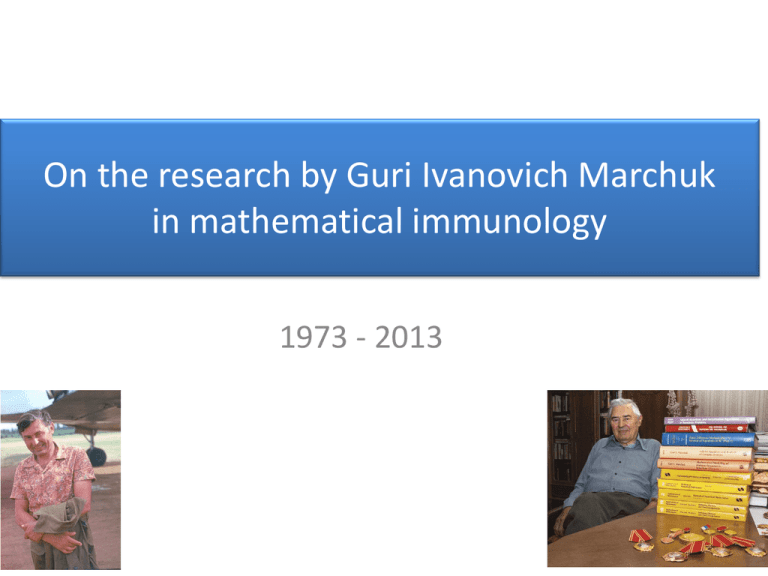
On the research by Guri Ivanovich Marchuk in mathematical immunology 1973 - 2013 Complex nature of the immune system µsec/sec min/hour Systems level processes: pathology, protection (molecular: receptor-ligand , signal transduction, gene regulation) receptors, proteins 1 nm = 10-9 m viruses Cell populations: proliferation, differentiation, apoptosis, migration cells 1 µм = 10-6 m tissues organs 1 mm = 10-3 m Organism 1m Mathematical immunology Mathematics: Studies the Notions of Quantity, Structure, Space and Change Immunology: The science of biological, chemical and physical aspects of the immune system functioning to maintain the antigenic homeostasis Mathematical immunology can be defined as the branch of mathematics dealing with the application of mathematical methods and computer technologies to explore the structure, organization and regulation of the immune system in health and disease Underlying processes Physical •Transport •Diffusion Chemical • Ligand-receptor • Signal transduction • Peptide synthesis Biological •Cell division (~6 hrs) •Cell differentiation •Cell apoptosis •Gene regulation •Generation of antigen receptor diversity Основная функция – защита от инфекций Four dynamic patterns of infectious diseases: (i) subclinical, (ii) acute with recovery, (iii) chronic, (iv) lethal infection Pathogen load †Lethal infection Chronic persistence: Why? How to cure it? Acute followed by recovery Subclinical t (time) Objective: to stimulate the specific immune response => Exacerbation „Parameters“ that determine the outcome of virus infection: Underlying processes Physical •Transport •Diffusion Chemical • Ligand-receptor • Signal transduction • Peptide synthesis Biological •Cell division (~6 hrs) •Cell differentiation •Cell apoptosis •Gene regulation •Generation of antigen receptor diversity The clinician‘s perspective: Health condition of the infected individual (Tx patient, newborn etc., age) Immunopathology Cytopathicity of virus Persistence Tropism Latency Dose of infection The „numbers game“ (mathematical) perspective: •replication rate •immunological parameters of the host •kinetics of the virus-host interaction Dynamic interplay between virus & host factors in the outcome of infection View of the viruses & the host as competitors for ‘resources’ of survival Virus Replication Immune Response Replication rate in virus persistence: pro & contra • Earlier experimental studies with LCMV infection in mice suggested that the faster speed of virus replication is an advantage for a virus in overcoming the immune system control and establishing the persistent infection – the tolerance by exhaustion (Moskophidis et al., Nature (1993) 362: 758-761) • Theoretical prediction: Slow virus replication favors the long-term persistence (Marchuk and Belykh, 1980) Fundamental models Mathematical immunology and the nuclear chain reaction George Irving Bell Гурий Иванович Марчук 4.08.1926-28.05.2000 • • • • • • Harvard University (Physics) - 1947 Division “T” Los Alamos Scientific Laboratory - 1947 “Nuclear reactor theory” - 1970 Quantitative models in immunology - 1970 Theoretical Biology & Biophysics. Los Alamos NL - 1974 Humane genome Project – 1988 8.06.1925-24.03.2013 • • • • • Math-Mech. Of the LSU – 1949 Division “B” of the Physics and Energetics Institute 1953 “Numerical Methods for Nuclear Reactors” – М. 1959 Mathematical modelling in immunology - 1975 CS of the SB of the USSR AS (1964), INM USSR AS, RAS (1980) Математические модели иммунного ответа на размножающийся антиген G.I. Bell: A mathematical description for replicating antigen (1973) • Lotka-Volterra-type of equations • Predator-Prey view Pathogen Г.И. Марчук: Mathematical model of infectious disease (1974) • Original system of delay differential equations • Target organ damage • Competition between the virus population and the host for the survival resources + Immune system Target organ Clonal Selection Theory: F. Burnet, N. Jerne, D. Talmage Lymphocytes bearing Ag-specific receptors (Ig) Virus expressing Ag www.biology.arizona.edu Key postulates: 1. Each responsive cell makes & expresses on its surface only a single type of antibody (Ig) molecule 2. The selective event is the stimulation by antigen of those cells which make complementary antibodies 3. This results is proliferation of cells and secretion of the Abs Immunological Scheme of the basic model of infectious disease Plasma cells Target organ Immune response B cell Pathogens B cell B cell Antibodies Basic model of infectious disease (1975) State space variable 1. Pathogen population 2. Antibodies 3. Plasma cells 4. Tissue damage System of Delay-Differential Equations d V (t ) F (t ) V (t ) dt d F (t ) C (t ) F (t ) V (t ) f F (t ) dt d C (t ) ( m ) V (t ) F (t ) f C C * dt d m ( t ) V ( t ) m m ( t ) dt Initial data V (t0 ) V0 , F (t0 ) F0 , C (t0 ) C0 , m(t0 ) m0 , V (t ) 0, F (t ) F0 for t t0 , t0 Immunostimulating therapy via exacerbation of the chronic infection Passive therapy Major breakthrough made by G.I Marchuk by 1980 (A.L. Asachenkov, L.N. Belykh, I.B. Pogozhev, A.A. Romanyukha, N.V. Pertcev, S.M. Zuev, ) • Kinetic basis of the chronisation of infectious diseases • Quantification of the immunological barrier (VIB) • Influence of organism’s temperature reaction on the course of disease • Novel views on treatment (1) of the hypertoxic form of disease and (2) the chronic infections via exacerbation Dual Recognition Principle via MHC restriction: P. Doherty and R.M.Zinkernagel Академик Рем Викторович Петров MHC class I – Ag complex Components of the antiviral immune response Mathematical Model Scheme 1981 Marchuk-Petrov model of the antiviral immune response (1981) •Virus population •Antigenpresenting cells •Тh1 cells •Тh2 cells •Т-cell effectors •В-cells •Antibodies •Infected cells of the target organ •Destroyed tissue Family of Nested Mathematical Models d V (t ) F (t ) V (t ) dt d F (t ) C (t ) F (t ) V (t ) f F (t ) dt d C (t ) ( m) V (t ) F (t ) f C C * dt d m ( t ) V ( t ) m m ( t ) dt V (t0 ) V0 , F (t0 ) F0 , C (t0 ) C0 , m(t0 ) m0 , V (t ) 0, F (t ) F0 при t t0 , t0 Scientific monographs by G. I Marchuk 1980 г. 1985 г. 1991 г. 1997 г. Application example: Hepatitis B Virus Infection HBV infection dynamics in volunteer subjects (from Fong et al., J. Medical Virology, (1994) 155-158) 6 patients out of 12 3 patients out of 12 What are the factors that determine whether an individual with acute hepatitis B will resolve the illness or will develop chronic infection? Sensitivity analysis using Adjoint Equations Modelling of Immunophysiological Processes Academician V.A. Chereshnev Special Issues related to Mathematical Immunology Ronal R. Mohler (Oregon State University, USA) A.V. Balakrishnan (University of California, Los Angeles, USA) 1978 г. 1983 г. 2005 г. 2011 г. Quantification of the tissue damage and the individual patient based assessment of the recovery process for hepatitis virus infection (k ) - disease severity index for k-th patient Normal recovery Academician N.I. Nisevitch, I.I. Zubikova, I.B. Pogozhev 95% normal recovery band Complications Quantification of disease severity of the lung infections Severity index Prof. E.P. Berbentsova Severe outcome Favourable dynamics Score time Monographs on Clinical Applications of Mathematical Models Co-authored with N.I. Nisevitch, I.I. Zubikiva, I.B. Pogozhev 1989 г. 1981 г. Co-authored with E.P. Berbentsova Virus Hepatitis Upper respiratory tract and lung infections Соратники и ученики научной школы Г.И. Марчука в области математической иммунологии • • • • Петров Р.В. (ИИ МЗ, Москва) Ю.М. Лопухин (2 МОЛГМИ, Москва) Нисевич Н.И., Зубикова И.И. (2 ММИ, Москва), Бербенцова Э.П., Агафонникова К.И., Тамбовцева Л.Г. , Францева Н.М. (МЗ РСФСР) • Черешнев В.А. (ИИФ УрО РАН, Екатеринбург) • Асаченков А.Л., Белых Л.Н., Зуев С.М., Перцев Н.В., Романюха А.А., Погожев И.Б., (ВЦ СО АН СССР, Новосибирск) • Бочаров Г.А., Дружченко В.Е., Каляев Д.В., Скалько Ю.И., Сидоров И.А. (ОВМ АН СССР, Москва) • Руднев С.Г., Каркач А.С., К. Авилов (ИВМ РАН, Москва) • Гайнова И.А. (ИМ им. С.Л. Соболева, СО РАН, Новосибирск) • Ким А.В. (ИММ, УрО РАН, Екатеринбург) Modelling in immunology: Experimental and Mathematical Nobel Prize Laureate Rolf M. Zinkernagel Academician Guri I. Marchuk „The outcome of infection results from the ´numbers games´ between infectious agent and the immune system.“ Mathematical Biology: Conceptual Foundations • Vito Volterra • Ludwig von Bertalanffy • Andrey Kolmogorov • Norbert Winer Mathematical immunology: conceptual foundations set up by G.I. Marchuk • Coordinatisation of complex phenomena in immunology of infections • • • Parameterization of the underlying processes differing in their nature Informative measures for the severity of disease and protection against infection Feedback regulation principles of the immune responses during infections • A nested family of relevant mathematical models of the within-host dynamics of infectious diseases formulated with delay-differential equations • • • Basic model of infectious diseases Marchuk-Petrov model of antiviral immune response Models of hemopoiesis • Practical application of mathematical methods to clinics • • • • • Clinical and laboratory indices of disease severity Patient-specific assessment of the disease course Hepatitis infection Pneumonia Myocardial infarction • Methodology for description, explanation and prediction in immunology based on mathematical models • • • Hepatitis B virus infection Influenza infection Viral-bacterial infection Credo “Спрашивается, имеет ли смысл рассматривать столь сложные модели при нынешнем состоянии медицины, когда эти параметры для индивидуального больного пока еще определить невозможно? Мы считаем, что смысл, и большой, имеется по двум причинам, Во-первых, подобные модели позволяют все более глубоко проникать в динамику сложнейших процессов защитных реакций организма от антигенов и выявить общие закономерности в динамике заболевания. С другой стороны, сложные модели ставят проблемы идентификации их параметров и, таким образом, стимулируют как математиков, так и медиков к поиску оптимальных систем оценок параметров моделей для индивидуального больного. Ведь будущее медицины – лечение индивидуального больного на основе слежения за его индивидуальными иммунологическими, эндокринологическими, сосудистыми особенностями с учетом непрерывно приобретаемых с возрастом хронических локусов различной этиологии. Именно такая перспектива всегда двигала автора и его коллег к тщательному и все более усложняющемуся математическому моделированию”. Future challenges: Control of infectious disease and the personalized therapy Thank you for your attention!
